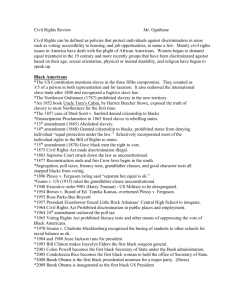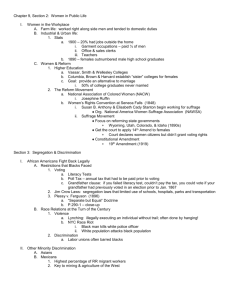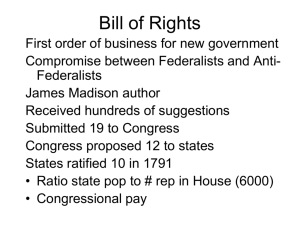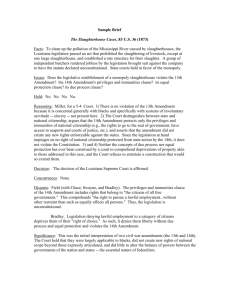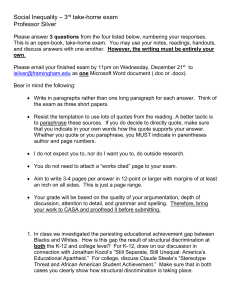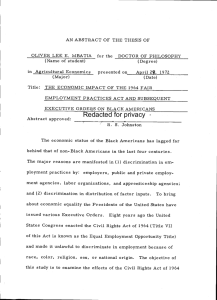Civil Rights in American Politics
advertisement
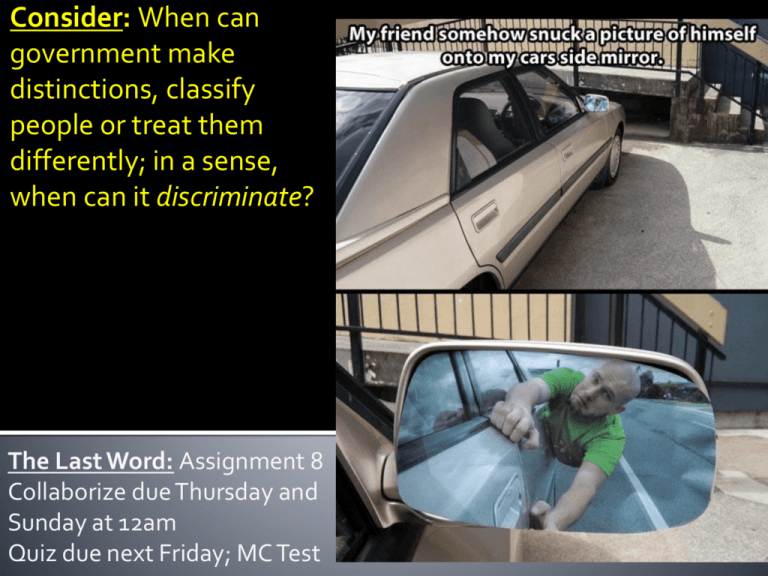
Consider: When can government make distinctions, classify people or treat them differently; in a sense, when can it discriminate? The Last Word: Assignment 8 Collaborize due Thursday and Sunday at 12am Quiz due next Friday; MC Test AP American Government Chapter 5 Homework: Assignment 8 Collaborize due Thursday and Sunday at 12am Quiz due next Friday; MC Test Rights accorded to every citizen “Rights to personal liberty established by the 13th and 14th Amendments to the U.S. Constitution and certain Congressional acts, especially as applied to an individual or a minority group.” The idea that we are all equal, and deserve the same rights no matter who we are or where we live Based mostly on the “equal protection” clause of the 14th amendment Also due process clause, privileges and immunities clause of the 14th Laws cannot discriminate, or treat people differently, unless they are reasonably related to some justifiable government objective Otherwise, these laws are considered unconstitutional. Is “equality” mentioned anywhere in the original text of the Constitution? Where/when does the idea that all Americans (or people) are equal first appear? When does the idea first make it into the Constitution? What was the purpose of this amendment? 14th amendment: Section 1. All persons born or naturalized in the United States, and subject to the jurisdiction thereof, are citizens of the United States and of the State wherein they reside. No state shall make or enforce any law which shall abridge the privileges or immunities of citizens of the United States; nor shall any State deprive any person of life, liberty, or property, without due process of law; nor deny to any person within its jurisdiction the equal protection of the laws. Not until 1857—fifty-four years after Marbury—was a second act of Congress declared unconstitutional by the Supreme Court. In the infamous Dred Scott case, the Court ruled that: African-Americans were not citizens, and therefore could not sue in court The Missouri Compromise was unconstitutional; fed had no power to regulate slavery in new territories The Court also presented a “parade of horribles” argument listing what the Court considered to be the inevitable and undesirable effects of granting Scott's petition: It would give to persons of the negro race, ...the right to enter every other State whenever they pleased, ...to sojourn there as long as they pleased, to go where they pleased ...the full liberty of speech in public and in private upon all subjects upon which its own citizens might speak; to hold public meetings upon political affairs, and to keep and carry arms wherever they went. While the name of the Supreme Court case is Scott vs. Sandford, the respondent's surname was actually "Sanford". A clerk misspelled the name, and the court never corrected the error. Begins with the passage of the 13th and 14th amendments Reconstruction does little for African-Americans in the South For nearly a century afterwards, very little changes Plessy vs. Ferguson (1896) Rules that even the “equal protection” clause only means government must provide equal (but can be separate) facilities The “equality” of these facilities was often questionable Not until the 1940s/50s do blacks see any change in their circumstances – why? Organized minority opposed granting rights to blacks Racism was still a majority sentiment Blacks could not vote Thus using the legislature was not the preferred strategy Why did civil rights leaders turn to the courts to attempt to gain civil rights? Beginning in the 1930s, the NAACP begins to fight the "separate but equal" doctrine (Plessy). Chose to concentrate efforts on segregation in public education, where they thought the adverse effects of the enforced racial separation could be most easily demonstrated. Several court decisions chipped away at the SbE doctrine before Brown abolished it legally Gaines vs. Canada(1938) – black student must be permitted to attend white law school, but what was the catch? Sweatt vs. Painter (1948) – even a SbE facility (law school) could not provide equal opportunities (protection) for blacks How did the Brown decision reach a different conclusion? What was part of the rationale for this decision based on? Why was Brown II needed? Reargued on the question of relief April 11-14, 1955. Opinion and judgments announced May 31, 1955. 1. Racial discrimination in public education is unconstitutional,…, and all provisions of federal, state or local law requiring or permitting such discrimination must yield to this principle. P. 298. 2. …the cases are remanded to the District Courts to take such proceedings and enter such orders and decrees consistent with this opinion as are necessary and proper to admit the parties to these cases to public schools on a racially nondiscriminatory basis with all deliberate speed. After Brown, however, Civil Rights leaders recognized the need to change public opinion, not just to win legal battles Court decisions were sometimes difficult to enforce, and Congress was often reluctant to act on Court decisions or change the law The movement begins using non-violent civil disobedience Attempt to appeal to moderate whites who were nonetheless disinterested in the plight of blacks What changed to enable the “Rights Acts” of the 60s to be enacted? Public opinion changes Images of violence against non-violent protestors Assassination of JFK believed by some to be right-wing anti-civil rights motivated Outlawed arbitrary discrimination in voter registration Barred discrimination in public accommodations engaged in interstate commerce (Heart of Atlanta tested this section and the Commerce clause) Prohibited discrimination in employment based on race, creed, color, religion, nationality or sex Created the EEOC
